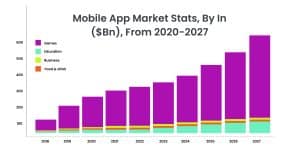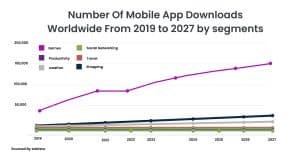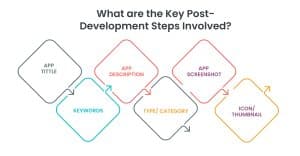Introduction
In today’s digital age, mobile applications development become an integral part for both personal and professional aspects of our lives. From communication to productivity, entertainment to e-commerce, Store to door ,mobile app cater in diverse range and diverse industry. Thank to technology advancement we live in this digital age of mobile app so we can fulfil our requirements easily .However, the landscape of mobile app development is constantly evolving, influenced by technological innovations, market trends, and user expectations. The global mobile app revenue is expected to reach an astounding $935 billion by 2024, according to Statista. You are aware of how mobile app development company could benefit businesses. And those benefits go beyond just the short-term bottom line. Digital engagement could pave new ways for long-term customer engagement and loyalty. When you invest in well-structured iOS and Android app development projects, you’re planning for the long shot.
While a staggering number of small and large businesses have taken benefit of mobile, some are yet to have the right strategy in place. Success can become a reality for your enterprise, but only if guided by an expertly crafted mobile application development process.
So, without further ado, let’s discuss the distinct phases of mobile application workflow and development step by step. Regardless of the size and scope of mobile applications, following the below development process will make mobile apps a sure shot success.
You are aware of how mobile app development company could benefit businesses. And those benefits go beyond just the short-term bottom line. Digital engagement could pave new ways for long-term customer engagement and loyalty. When you invest in well-structured iOS and Android app development projects, you’re planning for the long shot.
While a staggering number of small and large businesses have taken benefit of mobile, some are yet to have the right strategy in place. Success can become a reality for your enterprise, but only if guided by an expertly crafted mobile application development process.
So, without further ado, let’s discuss the distinct phases of mobile application workflow and development step by step. Regardless of the size and scope of mobile applications, following the below development process will make mobile apps a sure shot success.
Mobile App Usage in Numbers
There are more than 3 billion smartphone users across the globe. So, there is no doubt that the industry is expanding. Global mobile apps users are now growing steadily. And it’s a trend analysts say will continue throughout the decade.
- Tablet owners spend nearly three times more on apps than those who don’t own a tablet.
- The average smartphone user spends 90% of their mobile time in apps, with mere 10% spent surfing the web.
- Mobile apps can be developed on multiple platforms to reach the largest potential audience and maximize revenue.
- Android has nearly 3.5 million apps while iOS users can choose from just 2.2 million apps.
- Half of the applications available on the App Store have never been downloaded.
- Thousands of apps are released daily. With over 100,000 Android and 30,000 iOS apps released each month.
- Android is the most popular mobile operating system in the world having 73% market share.
- Over 50% of shoppers prefer shopping on mobile apps rather than desktop websites.
Mobile App Development – An In-Depth Overview
From a technical point of view, building a mobile app is a procedure to create software that runs on mobile devices. The app is later downloaded and installed from the App Stores. To build a mobile app, there are several things to consider, including screen size, features, app development platform, designs, and many more. Thus, there is a need to hire mobile app developers, having the expertise to work on your requirements. The types of mobile apps developed by developers include Native, Hybrid, and cross-platform apps. Here we will learn about mobile app development steps.What steps are included in the Mobile App UI/UX Design Process?
Pre-Development Planning
An unappealing mobile app leaves a bad impression on the end-users, making them motivated to use a different app. That’s why it is essential to optimally utilize the time and build a successful app on the first try. The first step towards a mobile app development process is properly planned and structured with deep analysis. Having a plan provides a well-guided path for app design and development, easy to identify mistakes, anticipate problems, and ensure intuitive app experiences. Most of the time the initial stage is overlooked, leading to a dull mobile app development process. Setting goals, defining features, and gaining insights are equally significant steps in an ideal mobile application development process. In addition, a pre-development plan is helpful to estimate the budget and lets you plan strategies.Strategy and Analysis
The detailed analysis helps create an effective strategy for the mobile app development plan. Objectives for mobile app development differ from business to business as per their set of requirements. You need to look for answers to several questions to create a streamlined process in app development. The following points will help to build a productive mobile app by utilizing market research correctly:- App Objective: Defining the mobile app objective is easier than you think. You must answer the following questions- Does your brand need a mobile application? What solutions does the app provide for your business? Can your business plan include a mobile app? Do you have the budget to start a mobile app development process? How to start the application development process?
- Target Audience: Without a target audience in mind, you will not be aware of whom you’re making the app. Analyse the latest market trends, demographics, and users to target a particular audience segment.
- Functionalities:Once the objective and target audience are defined, it is easy to conduct further research to answer questions like- What are the key features of a mobile app? How is the app helping your end-users? How do mobile apps boost customer engagement?
- Competitor Analysis: Dig deeper into market research to learn more about the competitors and similar apps available. Analyse competition to build a mobile app that is unique and offers a better overall user experience.
- Investment Research: After creating a rough strategy from the above steps, it is time to create an approximate estimation of the app budget finances. This makes it simpler and comfortable for you to execute the mobile app development process.
- Planned Marketing: This plan is for the post-development stage. Without a marketing plan for the mobile app, the number of downloads, and customer engagement will stay low. Use the data insights to decide the best formats, mediums, and platforms for the app marketing purpose.
What steps are included in the UI/UX Design Process of Mobile Apps?
The main objective of the mobile app’s user interface is to offer a smooth and flawless user experience to the target audience. Even with the top-rated functionalities, the mobile app may fail to bring the desired outcome if your audience finds it challenging to use. Delivering user-friendly, and spontaneous user experiences are crucial to making your app shine among the ever-growing competition in the digital world. Simplify the entire process of app design and development by dividing the process-- Define and ideate multiple features for your app.
- Work on the best design features and ideas.
- Build a design mockup with the most appealing design features.
- Customize and finalize the app design for further development work.
What Tools & Techniques Are Used in the App Development Process?
Once your mobile app research, plan, and design are completed, the second phase begins that is the app development process. The actual coding work begins at this stage. There is a plethora of frameworks, programming languages, and technology stacks for app development, and real expertise comes into play to choose the right ones. This ultimately helps to achieve maximum efficiency in the backend, API, and frontend work.Backend/Server-side Operations
The Back-end or server-side job is to secure, store and process data. And to keep the mobile app running without trouble, it is important to select the right technology. Without appropriate backend development, the mobile app lacks stability and optimal performance. It is the backbone of mobile application development, and thus selecting the most suitable programming language becomes a necessity. Trending mobile app development libraries and tools for the backend:PHP
NodeJS
AngularJS
ReactJS
Golang
.NET
Ruby on Rails
Application Program Interface
Application Program Interface is all about determining the interactivity of the software components inside the app. Along with seamless accessibility and sharing of the app’s information, API supports an app in accessing data of other apps as well, making it an essential tool.Frontend/Client-side Operations
The front-end is the interface that your end-users interact with. With a seamless user experience, you can engage your audience and retain customers. There are different techniques to perform front-end development for mobile apps:Why Opt for Native App Development?
This is a platform-specific iOS and Android app development process. It needs different teams of developers to build separate codebases for both platforms. Being a costly and time-consuming way of development, it provides 100% output and remarkable functionality to the mobile app. Tools for iOS mobile app developmentObjective-C
Swift
Xcode
Java
Kotlin
Android Studio
Why Opt for Cross-Platform App Development?
Several full-fledged frameworks are available to develop cross-platform mobile apps using a single codebase. With a “write once, use everywhere” principle, this technique simplifies the development work by eliminating a huge portion of the developers’ time as well as effort. Tools for Cross-platform mobile app developmentIonic
Flutter
Cordova
Xamarin
React Native
PhoneGap
Why Opt for Hybrid App Development?
This mobile application development method integrates the elements of a web app in native app development. With optimized performance and scalability, this technique provides fast-paced development and simple maintenance. Languages for Hybrid app developmentHTML5
CSS
JavaScript
Why is Testing an Essential Part of Mobile Application Development?
App testing streamlines the mobile app development process and takes it up a step ahead. Quality assurance (QA) with proper testing is the best means to guarantee optimal usability and security. A quality assurance team performs different tests to check the outcomes targeted in the pre-development stage. Without a comprehensive testing process, the app may result in an unsatisfactory and defective one. Modifications are added to finalize the mobile app for deployment.User Experience Testing
User experience testing is performed to evaluate the app design to ensure a smooth user interface. The final interface should be like the app design prototype developed in the pre-development stage. This test makes sure that the audience gets an unforgettable experience while using a mobile app with the proper color scheme, style sheet, data architecture, and navigation.Functional Testing
Functional testing helps to evaluate distinct functions of the mobile app. The app must run efficiently while being used by different users at the same time. Every app functionality must be thoroughly tested to make sure that the app works correctly after being launched. Functionality tests identify several unexpected mistakes and defects that can be addressed to provide remarkable features for end-users.Performance Testing
The real test of an app comes into play when multiple end-users use it. App loading speed, app size, response to change, and optimization to consume less phone battery are all tested to ensure top-notch performance. Security Testing Security is the most integral part of building mobile app. Security tests clear the risk of viruses and hackers while protecting sensitive data and databases. The importance of security testing doubles if your app has payment portals. Your testers can check vulnerabilities in the app and identify potential breaches to address them.What are the Key Post-Development Steps Involved?
After the completion of different mobile app development stages, the time has come to launch your app. App deployment and post-launch maintenance are highly crucial steps of the app development process. Deployment You need an experienced mobile app developer to perform deployment work with app platforms including Google Play Store and Apple App Store. The following data is needed to submit the mobile app
- App title
- App description
- Keywords
- Type/category
- Icon/thumbnail
- App screenshots
Maintenance and Support
Once a mobile app is ready to download, it is essential to track the crucial metrics to measure the mobile app’s overall performance and success. Give attention to suggestions, comments, ratings, and feedback to address problems and offer continuous improvements. Stay updated with the advanced technological trends and market behaviour to offer new releases according to the end-user needs and requirements. Mobile apps have become a necessity to expand business in a competitive, digital-driven market. With the ever-increasing demand for mobile apps, businesses are investing in mobile app development services. Forming a strategy using market analysis, selecting the right technologies for programming, and evaluating the app to eliminate bugs, and releasing timely updates are the steps that are needed to launch a successful mobile app.Frequently Asked Questions
How much time is needed for Mobile app development?
The time to create a mobile app is based on several factors ranging from features, scalability, hosting server, and functionality.
Do you ensure the security & confidentiality of the app idea?
Yes, we sign a strict NDA to protect your app idea & data. Hence, we ensure the complete security and privacy of your mobile app development project.
Do you offer any post-deployment app maintenance?
We provide our clients with extended maintenance plans. We also fully support any app we design and develop if you encounter any problems or require any enhancements.
Do you sign an NDA?
Yes! When you reach us for the app development process, we sign a strict NDA and other legal documents for data security.

 PHP
PHP NodeJS
NodeJS AngularJS
AngularJS ReactJS
ReactJS Golang
Golang .NET
.NET Objective-C
Objective-C Swift
Swift Xcode
Xcode Java
Java Android Studio
Android Studio Ionic
Ionic Flutter
Flutter Cordova
Cordova React Native
React Native PhoneGap
PhoneGap